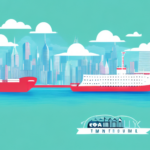Understanding FTL Shipping for E-Commerce Logistics
As the online retail landscape continues to expand, e-commerce businesses must deeply understand their logistics options. One such option is FTL (Full Truckload) shipping, which involves transporting a full truckload of goods from one location to another. This article explores the numerous benefits of FTL shipping for e-commerce, offers actionable implementation tips, and discusses the latest trends to ensure your logistics strategy remains competitive and efficient.
Benefits of FTL Shipping for E-Commerce Businesses
- Cost Savings: Shipping a full truckload can reduce overall shipping costs compared to LTL (Less-Than-Truckload) shipping, especially for larger shipments. Businesses can benefit from bulk rate discounts and lower per-unit shipping costs.
- Efficiency: FTL shipping streamlines the supply chain by minimizing transit times. With no multiple stops, shipments arrive faster, enhancing overall operational efficiency.
- Flexibility: Businesses can often schedule pickup and delivery times that best suit their needs, providing greater control over their logistics operations.
- Security: Dedicated truckloads reduce the risk of damage or loss since the cargo is not mixed with other shipments, ensuring safer transportation of goods.
Additionally, FTL shipping enables real-time shipment tracking. Advanced tracking technologies allow businesses to monitor their shipments continuously, ensuring timely deliveries and quick resolution of any transit issues, thereby maintaining high customer satisfaction.
Implementing an FTL Shipping Strategy
A Comprehensive Guide to FTL Shipping in E-Commerce Logistics
Implementing FTL shipping in your e-commerce business involves several key steps:
- Request a Quote: Begin by obtaining quotes from multiple FTL shipping providers to understand the costs and services offered.
- Book the Shipment: Choose a provider, and schedule your shipment, providing details on pickup and delivery locations, shipment size, and special requirements.
- Prepare the Shipment: Properly package and label your goods to ensure they are secure and easily identifiable during transit.
- Load the Truck: Collaborate with the FTL provider to load your goods onto the truck, ensuring that they are handled carefully to prevent damage.
- Track the Shipment: Utilize tracking tools provided by your FTL carrier to monitor your shipment’s progress in real-time.
- Receive the Shipment: Upon arrival, inspect the goods for any damages and ensure everything is in order before finalizing the delivery.
While FTL shipping can be more costly than LTL, the benefits of faster transit times and reduced risk of damage often outweigh the additional costs for larger shipments.
Choosing the Right FTL Shipping Provider
The Top Considerations for Selecting an FTL Provider for E-Commerce
Selecting the right FTL shipping provider is critical for the success of your logistics strategy. Consider the following factors:
- Experience: Opt for providers with a proven track record in handling e-commerce shipments and familiarity with the types of goods you transport.
- Reliability: Ensure the provider consistently delivers on time and maintains high standards of customer service.
- Cost: Compare pricing structures to find a provider that offers competitive rates without compromising on service quality.
- Technology: Choose providers that utilize advanced tracking and management tools to give you better visibility and control over your shipments.
- Insurance: Verify that the provider offers comprehensive insurance coverage to protect your goods against any transit-related issues.
Additionally, assess the provider’s network coverage to ensure they can deliver to all necessary locations, both domestically and internationally, leveraging a wide network for efficient delivery.
Cost Analysis of FTL Shipping
Understanding the Cost of FTL Shipping in E-Commerce Logistics
The cost of FTL shipping is influenced by factors such as shipment size, weight, distance, and specific pickup and delivery requirements. Generally, FTL is more cost-effective for large or long-distance shipments. Key cost considerations include:
- Shipment Dimensions: Larger and heavier shipments may incur higher costs, but these can be offset by the per-unit cost savings of FTL shipping.
- Distance: Longer distances increase fuel and labor costs, impacting the overall price.
- Additional Services: Services like expedited shipping or specialized handling may add to the cost.
Working with providers that offer transparent pricing and avoid hidden fees is essential for accurate budgeting and cost management.
Optimizing Your FTL Shipping Strategy
How to Optimize Your FTL Shipping Strategy for E-Commerce Success
To maximize the benefits of FTL shipping, consider the following optimization strategies:
- Consolidate Shipments: Combine multiple orders into a single shipment to reduce the number of trips and lower costs.
- Plan Ahead: Schedule shipments in advance to secure better rates and ensure timely deliveries.
- Build Relationships: Establish strong partnerships with reliable FTL providers to ensure consistent service and negotiate better terms.
- Track Your Shipments: Use advanced tracking systems to monitor shipment progress and address any issues promptly.
Trends and Innovations in FTL Shipping
The Latest Trends and Innovations in FTL Shipping for E-Commerce Logistics
Staying abreast of the latest trends in FTL shipping can give your e-commerce business a competitive edge:
- Big Data Analytics: Leveraging big data for route optimization and predictive analytics enhances efficiency and reduces costs.
- Mobile Technology: Mobile apps and real-time tracking tools provide greater visibility and control over shipments.
- Collaborative Shipping: Sharing truckloads with other businesses can improve load efficiency and decrease transportation expenses.
- Green Initiatives: Implementing sustainable practices, such as using alternative fuels and optimizing routes to lower emissions, supports environmental responsibility and can reduce costs.
Common Mistakes in FTL Shipping Implementation
Common Mistakes to Avoid When Implementing FTL Shipping in E-Commerce
To ensure a smooth FTL shipping experience, avoid the following common pitfalls:
- Choosing the Wrong Provider: Selecting an inexperienced provider can lead to delays and damaged goods. Conduct thorough research to find a provider that aligns with your business needs.
- Poor Shipment Preparation: Inadequately packaged or labeled shipments are more prone to damage. Invest in proper packaging materials and labeling practices to safeguard your goods.
- Neglecting Shipment Tracking: Failing to monitor shipments can result in unaddressed delays or issues. Utilize tracking tools to maintain oversight throughout the shipping process.
Measuring the Success of Your FTL Shipping Strategy
How to Measure the Success of Your FTL Shipping Strategy in E-Commerce
Evaluating the effectiveness of your FTL shipping strategy involves tracking key performance indicators (KPIs):
- On-Time Delivery: Measure the percentage of shipments that arrive on schedule to assess reliability.
- Shipping Costs: Analyze total shipping expenses to identify cost-saving opportunities and ensure budget adherence.
- Customer Satisfaction: Gather feedback through surveys to understand customer perceptions of your shipping performance and identify areas for improvement.
Future of FTL Shipping in E-Commerce Logistics
The Future of FTL Shipping in the Evolving Landscape of E-Commerce Logistics
As e-commerce continues to transform, FTL shipping is poised to evolve with it. Future developments include:
- Greater Use of Automation: Automation technologies will streamline FTL processes, reducing manual interventions and enhancing efficiency.
- Expansion into New Geographies: Globalization of e-commerce will drive FTL providers to extend their reach into new regional markets.
- Increased Focus on Sustainability: Ongoing investment in eco-friendly practices and technologies will become a standard, aligning logistics operations with environmental sustainability goals.
By embracing these trends and continuously refining your FTL shipping strategy, your e-commerce business can stay ahead in a highly competitive and rapidly evolving market.
For more information and resources on optimizing your e-commerce logistics, consult industry-leading publications such as Logistics Management or Supply Chain Digital.








